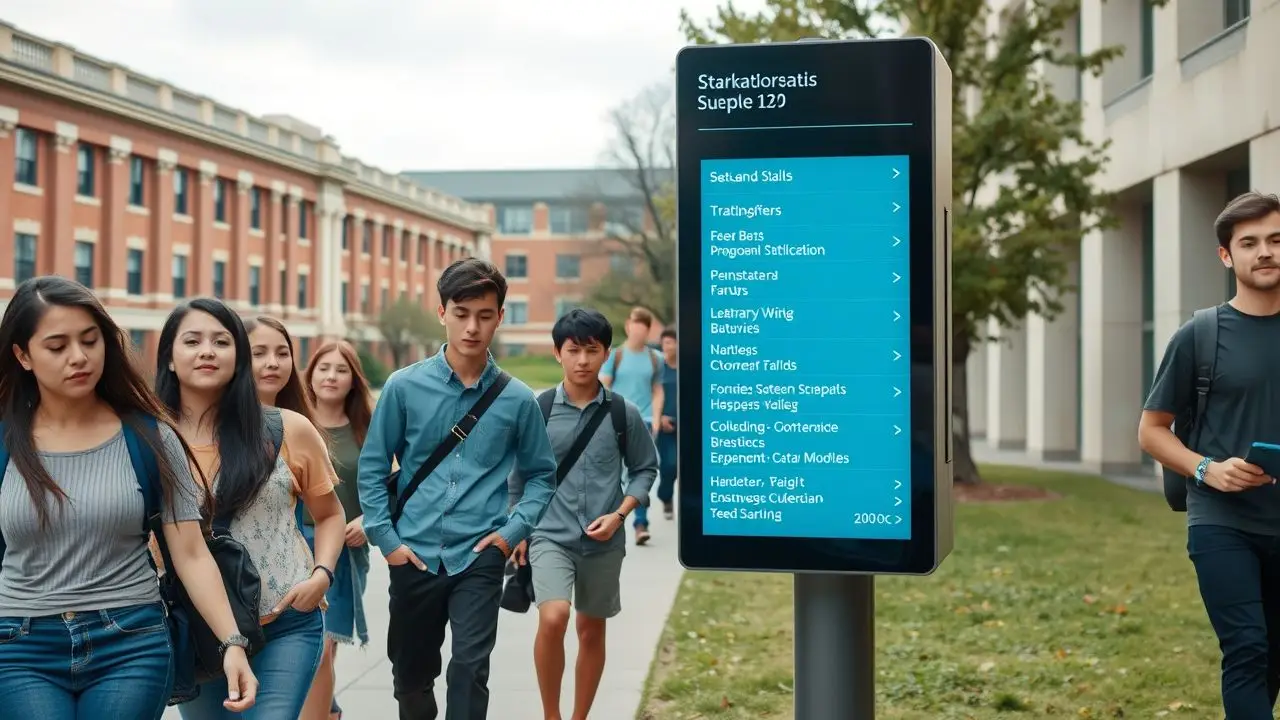Finding your way around a big university or college can be hard. A fact is, digital signs make it easier to find places on campus. This post will show you how these signs help students and visitors get around better.
Keep reading to learn more.
Key Takeaways
- Digital signs make finding places on campus easier with clear directions and real-time updates.
- These signs are interactive, allowing users to search for locations and get information quickly.
- Emergency alerts on digital signs keep everyone safe by sharing important messages fast.
- Installing digital wayfinding systems helps handle last-minute changes and prepare for emergencies better.
- Digital signage improves the overall campus experience by making navigation simple and enhancing school pride.
Table of Contents
ToggleUnderstanding Wayfinding at Universities and Colleges

Wayfinding helps people find their way around campus. It is key for students and visitors to feel comfortable and safe while moving through the school.
Definition of wayfinding
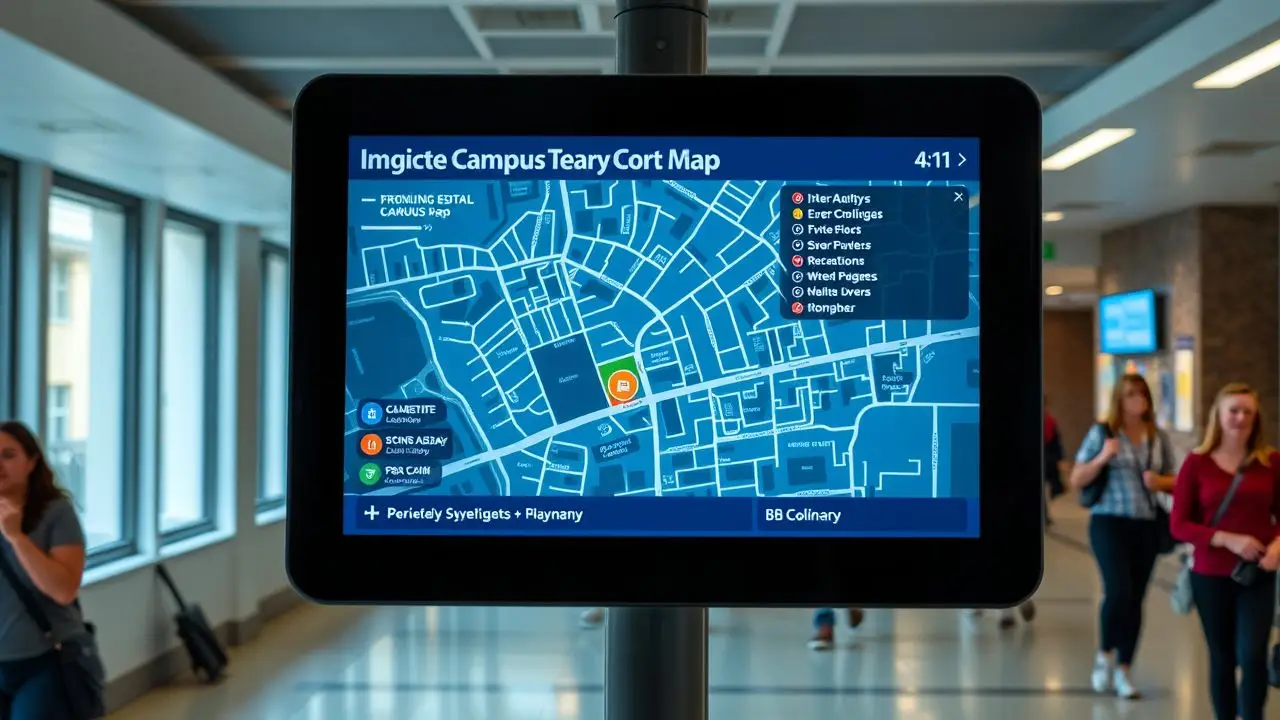
Wayfinding is the process of finding your way in a place. It helps people move around campuses easily. Good wayfinding allows students and visitors to locate buildings, classrooms, and services without confusion.
Digital signs improve campus navigation by providing clear directions and information. They can show interactive maps that help users find their destination quickly. These signs make the college experience simpler and more enjoyable for everyone on campus.
Importance of effective wayfinding for campuses

Effective wayfinding is key for universities and colleges. Students and visitors need clear paths to find their classes, libraries, or events. With busy campuses, good signage helps everyone move around easily.
Poor wayfinding can cause stress and confusion. Some people may get lost while trying to reach their destination. This can lead to late arrivals for important events or missed classes.
Digital signs improve campus navigation by providing real-time updates and interactive features. Clear directional signage makes it easier for everyone on campus to feel comfortable in their surroundings.
Challenges faced with traditional wayfinding methods
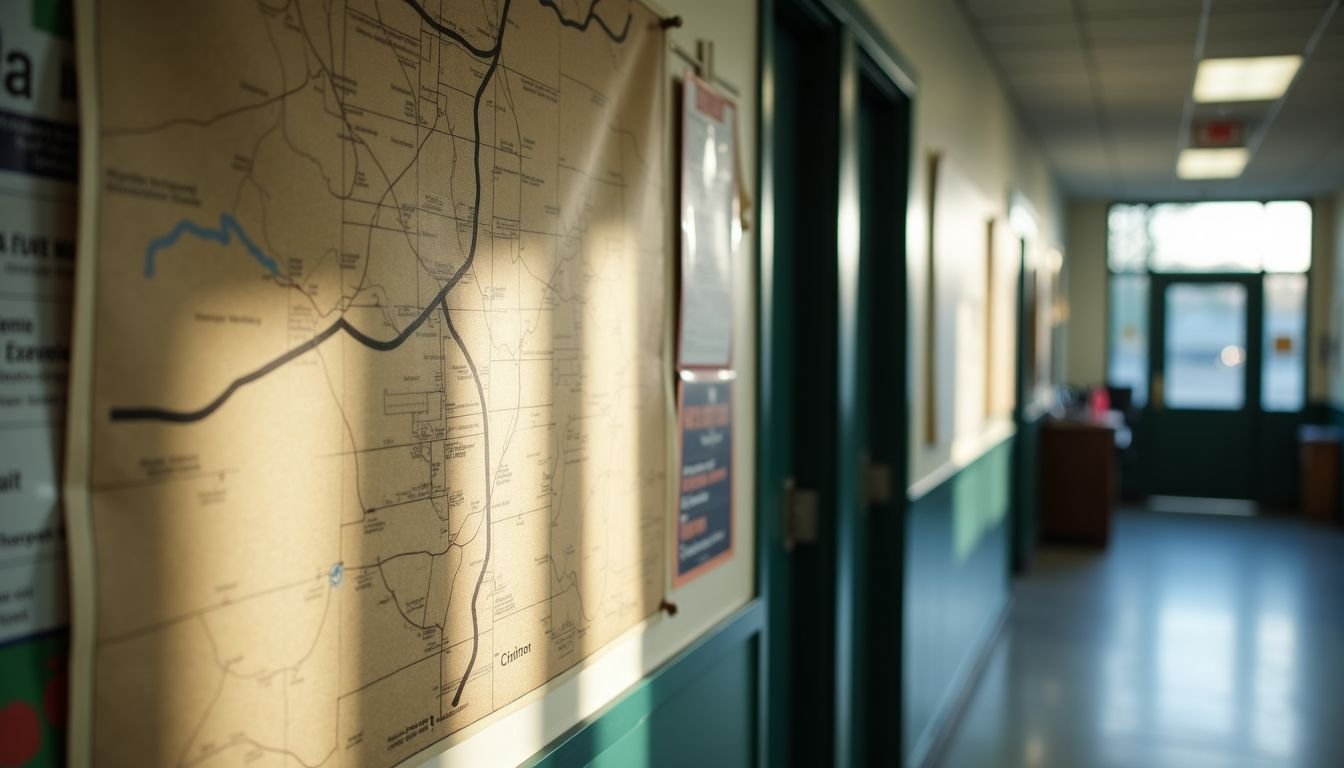
Traditional wayfinding methods can be confusing. Printed maps and signs often go unnoticed. Students may struggle to find classrooms or libraries. Many signs become outdated quickly, especially with event schedules changing often.
These tools do not provide real-time updates. As a result, people waste time looking for places. Emergency situations are harder to manage without clear directions. First-hand experience shows that digital displays solve many of these issues.
Digital navigation offers quick answers and guides students easily around campus spaces.
Benefits of Digital Signs for Wayfinding
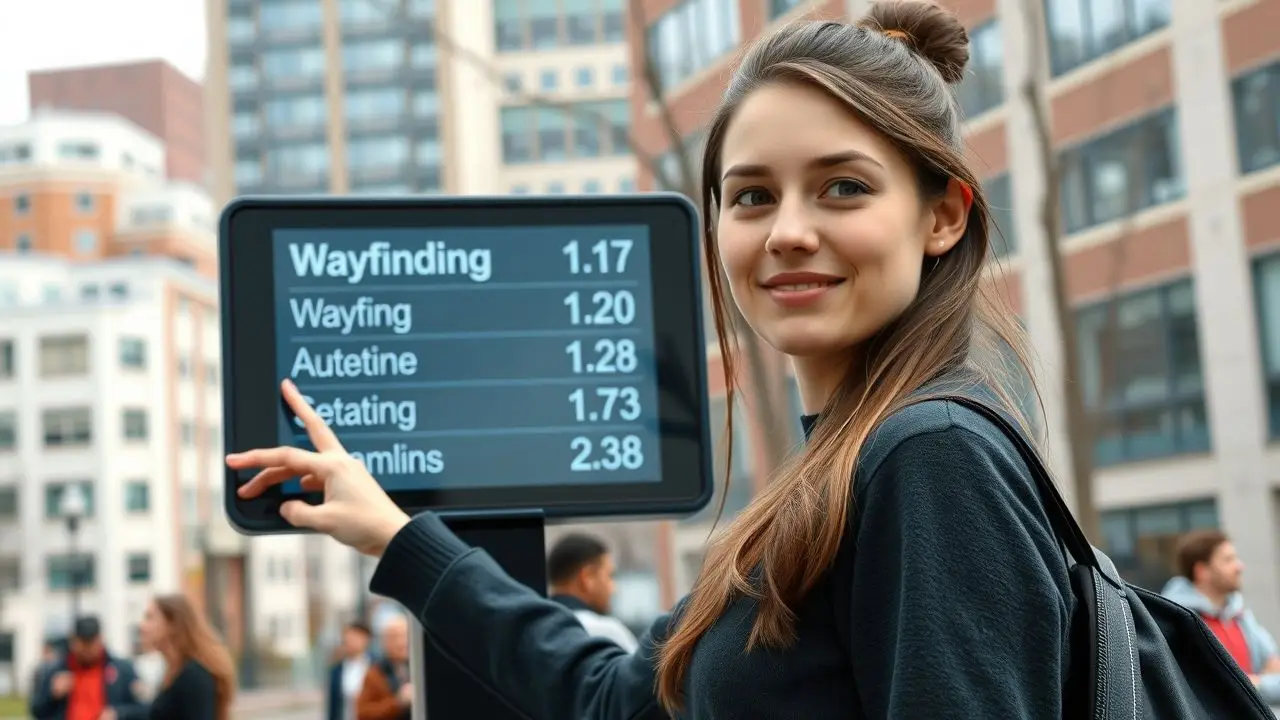
Digital signs provide real-time updates for information on campus. They offer interactive features that help students and visitors find their way easily.
Real-time updates
Digital signs can show real-time updates. This helps students and visitors find the right places on campus. For example, if a room changes or an event is moved, digital signs change quickly.
Everyone sees the new information at once.
These signs can also display important alerts. Emergencies may happen anytime, and timely messages are key. Real-time updates help keep everyone safe by sharing vital information fast.
Digital wayfinding improves the campus environment by making navigation easier for all users.
Interactive features
Interactive features on digital signs help students and visitors at universities. These signs allow users to touch screens for information. They can find directions, see class schedules, and learn about events in real time.
This makes campus wayfinding easier.
Users have a better experience with interactive signage. They can search for specific locations like classrooms or libraries quickly. Many campuses use this technology to improve campus signage.
With virtual directories, people save time on their trips around the campus. First-hand experience shows that these features reduce confusion and make navigation smooth for everyone.
Cost-effective remote maintenance
Digital signs allow for cost-effective remote maintenance. Schools can update their signs from anywhere. This means no need to send a technician every time a change is needed. Changes can be made in real-time, which saves both time and money.
Maintenance becomes easier with digital wayfinding systems. Schools can quickly fix issues without being on-site. This feature helps keep all signs up-to-date, including classroom signage and library labels, ensuring students find what they need fast.
Emergency broadcasting also works better when updates are simple to execute remotely.
Types of Digital Wayfinding Signs
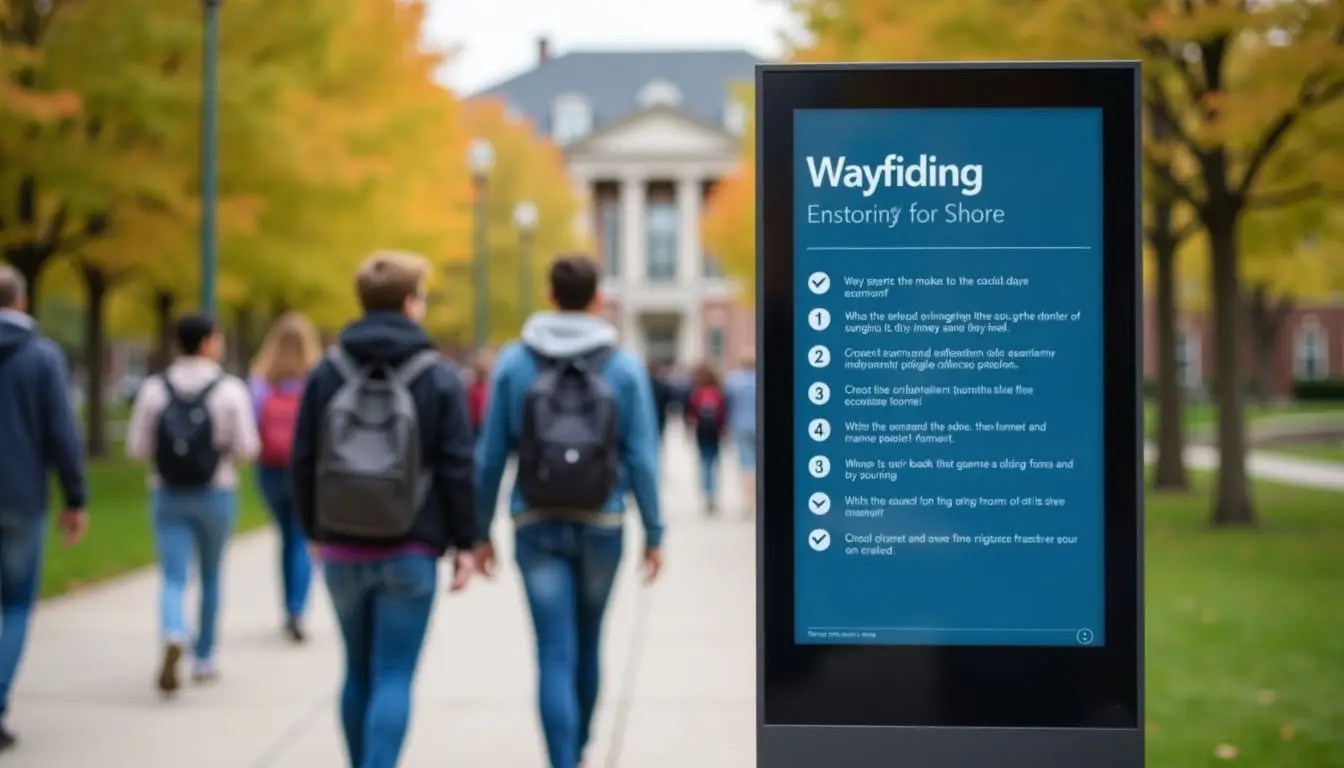
Digital wayfinding signs come in many forms to help guide people. They include signs that give information, show directions, identify buildings, and explain rules. Each sign has a purpose to make campus travel easier.
Want to learn more about how these signs can help?
Informational signs
Informational signs play a key role in digital wayfinding at universities and colleges. These signs provide essential details about the campus, events, and services. They can show maps that help students find their classes or locate facilities.
Real-time updates keep everyone informed about changes on campus.
With location-based technology, informational signs become interactive. Users can touch the screen for more information or directions. This feature makes it easier for new students to learn about their surroundings.
In busy environments like campuses, clear informational signs improve community cultivation and enhance indoor mapping efforts.
Directional signs
Directional signs are key for helping people find their way around campuses. They show the best paths to different buildings and areas. Digital signs offer real-time updates, which helps students and visitors stay on course.
If a path changes or a new building opens, these signs can update quickly.
Digital directional signs often include maps and arrows that guide users step by step. Many feature touch screens for interactive navigation. This makes outdoor navigation easier than ever in busy university settings.
With clear symbols and bright colors, these signs grab attention and make directions simple to follow.
Identification signs
Identification signs help people find buildings and services on campus. These signs show the names of schools, departments, and facilities. They make it easy for students and visitors to know where they are going.
Many universities use digital identification signs. These signs can be updated easily. For example, if a new program opens or a building changes its name, staff can change the sign quickly.
Real-time updates help everyone find their way without confusion. A first-hand experience shows how much easier it is for newcomers to locate important places like libraries or student centers with clear digital identification signs.
Regulatory signs
Regulatory signs are key to keeping campuses safe and organized. These signs inform students and visitors about rules they need to follow. For example, speed limits guide drivers on campus streets.
No parking signs show where vehicles cannot stop.
Digital regulatory signs can change quickly based on needs. They provide real-time updates about rules or emergencies. This clarity helps everyone feel secure while at the university or college.
Real-life experience shows that using digital signs improves safety for all who visit the campus.
Emergency signage
Emergency signage plays a vital role on college campuses. These signs provide important information quickly during crises. They guide people to safe locations or exits. Digital emergency signs can change in real time based on the situation.
These signs ensure that everyone stays informed and safe. They help reduce panic by giving clear directions when it matters most. Using digital signs improves wayfinding at universities and colleges, making emergencies easier to handle for all.
Implementing a Digital Wayfinding System for Universities and Colleges
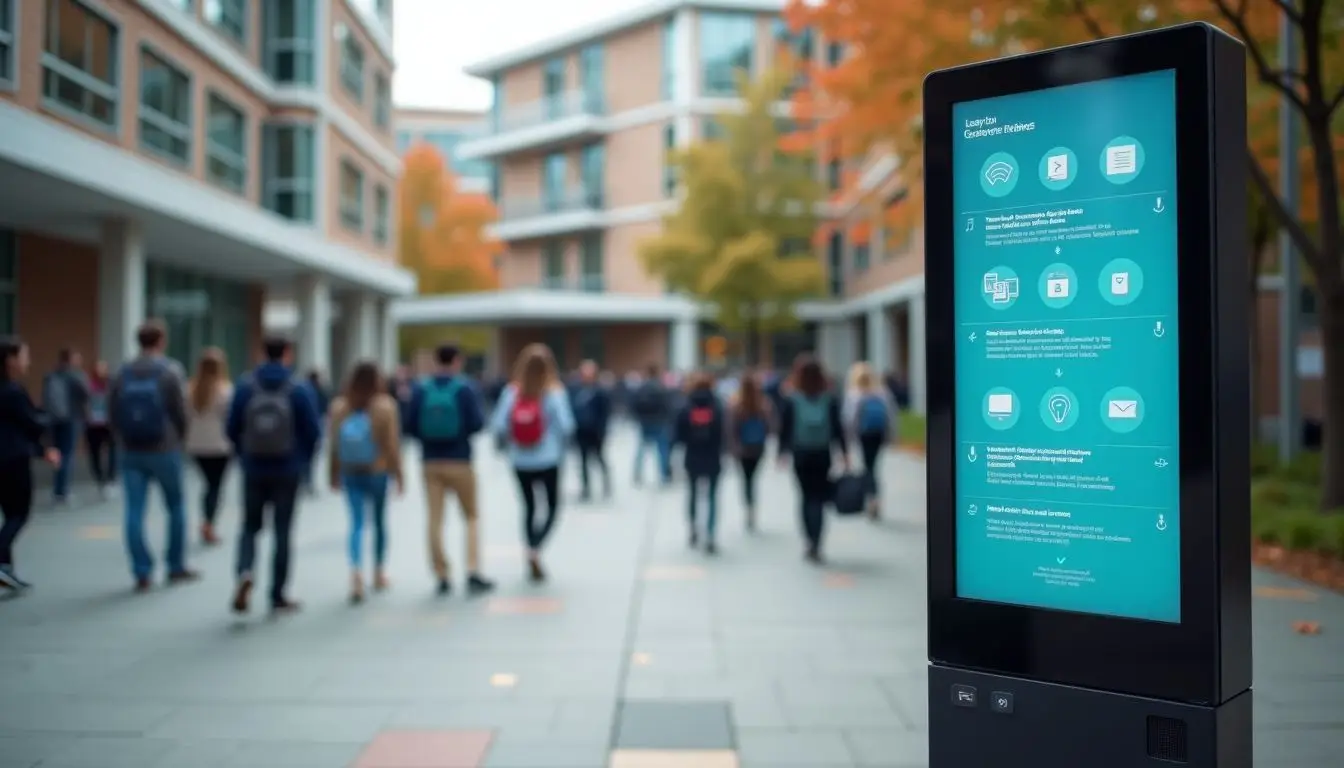
Implementing a digital wayfinding system can help universities and colleges create a better path for students and visitors. These signs provide clear guidance and quick updates. They can adapt to last-minute changes with ease.
This approach makes campus life smoother and safer. For more on this topic, continue reading!
The onboarding process
The onboarding process for digital wayfinding signs at universities and colleges is crucial. Schools need to prepare their staff and students for these new tools. Training sessions often help everyone understand how the signs work.
This hands-on approach gives people a chance to use the signs before they go live.
Digital signs offer real-time updates, which can be very helpful during busy times or emergencies. Staff learn how to update information quickly, making sure everyone stays informed.
First-hand experience with these systems helps users feel more comfortable using them daily. Using digital signage improves wayfinding on campuses through location-based technology, enhancing movement around school grounds.
Handling last minute changes
Digital signs help universities handle last minute changes easily. They can be updated quickly with new information. For example, if a class changes rooms or an event gets canceled, digital signs show the update instantly.
This keeps students and staff informed without delays.
First-hand experience shows that students appreciate real-time updates. Many feel less stressed when they see clear directions on screens. With these signs, campuses can respond to issues faster and improve wayfinding for everyone involved.
Preparing for emergencies
Digital signs help in emergencies at universities and colleges. They can show real-time alerts, guiding people to safety. Clear directions are crucial during crises. These signs inform students and staff about evacuation routes or dangerous areas.
A system that updates quickly supports safety efforts. In past events, schools with digital signage responded faster than those without it. Users felt more secure knowing they could get instant information when needed.
Digital signs truly enhance wayfinding by providing clear messages during emergencies.
The role of placemaking
Placemaking helps create a strong sense of community at universities and colleges. It makes spaces feel welcoming and connected. By using digital signs, schools can share important information in fun ways.
These signs can highlight events, point out attractions, or tell stories about the campus.
Effective placemaking encourages students to explore their surroundings. Digital wayfinding signs guide them easily through different areas. They show where to go for classes, activities, or dining options.
This creates a better experience for everyone on campus while improving wayfinding with location-based technology.
Enhancing overall campus experience
Digital signs improve the campus experience for students and visitors. They provide clear information about buildings, events, and services. Easy-to-read digital displays help people find their way quickly.
Students can see real-time updates on class locations or changes in schedules.
Wayfinding is essential for a smooth visit to a university or college. Digital signs make navigation simple and stress-free. This technology also creates an inviting atmosphere on campus.
Engaging designs attract attention and enhance school pride too. By using location-based technology, schools can offer a better experience every day.
Conclusion
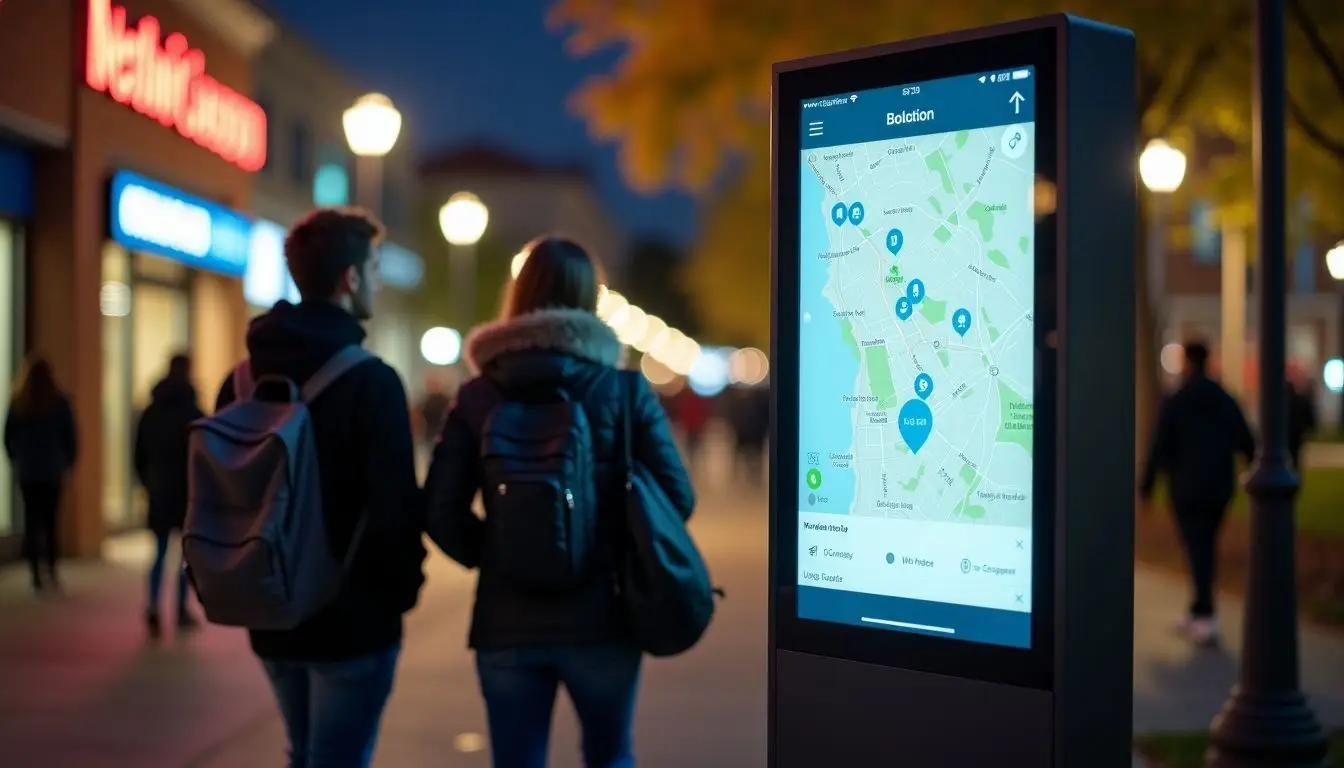
Digital signs boost wayfinding at universities and colleges. They provide clear directions and real-time updates. Students can find their classes quickly with interactive maps. These signs make campuses easier to navigate.
Using digital solutions enhances the campus experience for everyone.
FAQs
1. How do digital signs improve wayfinding at universities and colleges?
Digital signs are a form of location-based technology that guides students, staff, and visitors around campus. They provide clear directions and information to help people find their way.
2. What makes digital signs better than traditional ones for wayfinding in universities and colleges?
Unlike traditional signs, digital ones can be updated quickly with new information. This flexibility makes them more effective for navigating large campuses.
3. Can digital signs only be used for direction purposes at universities and colleges?
No, they’re not just for directions! Digital signs can also display important announcements or event details to keep everyone on campus informed.
4. Are there any challenges when implementing digital sign systems in universities or colleges?
While the benefits are clear, it’s essential to plan the locations of these signs carefully so they effectively guide people around campus.

